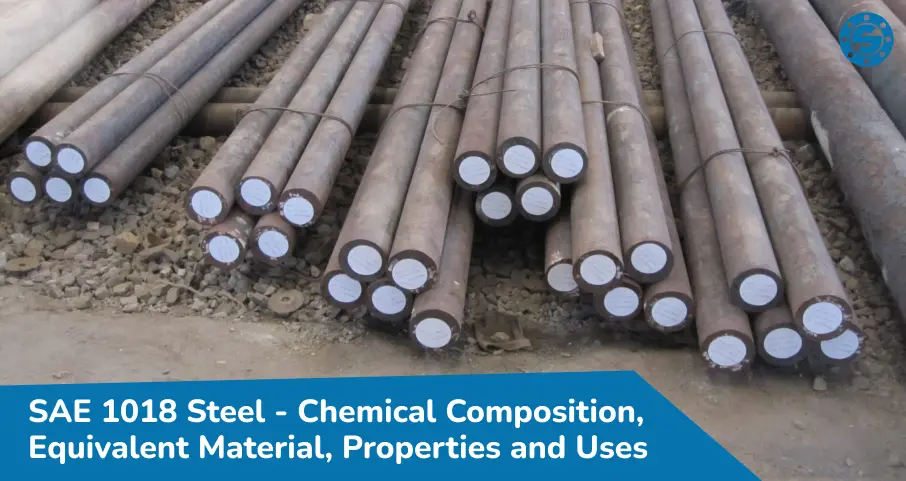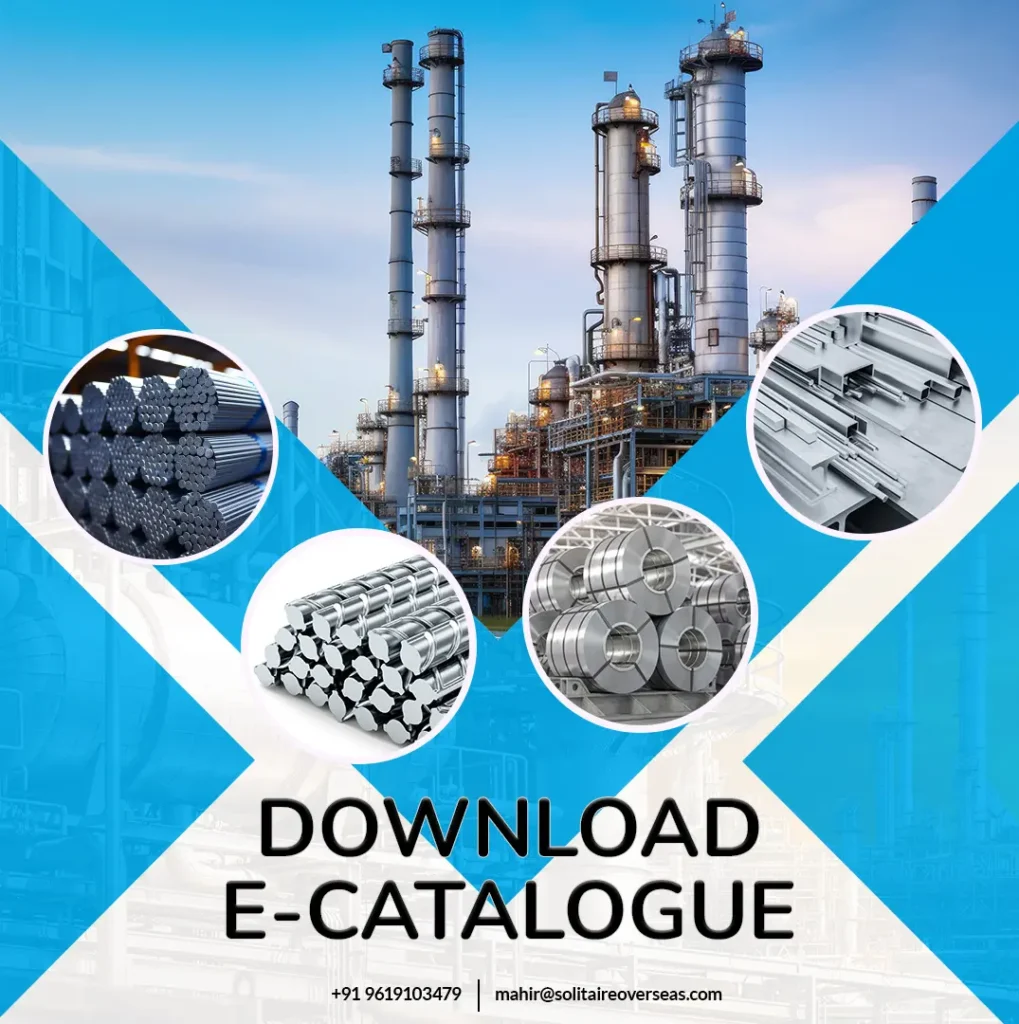SAE 1018 Steel - Chemical Composition, Equivalent Material, Properties and Uses

SAE 1018 mild carbon steel is known for its excellent versatility in fabrication, making it ideal for carburizing and creating parts with uniform hardness. It offers a good combination of strength, toughness, and ductility, along with great weldability and machinability. Its high Brinell hardness adds durability, making it suitable for applications requiring strength and wear resistance.
This steel falls under the carbon steel category, containing 0.12 to 2% carbon. As carbon content increases, its hardness and strength improve, but it loses some ductility, especially when heat-treated.
Despite not having unique mechanical properties, SAE 1018 is widely used for its ease of machining, welding, and fabrication, making it a go-to option for various industrial purposes. Its balanced characteristics make it a popular choice across multiple sectors.
SAE 1018 Chemical Composition
| Chemical Composition | ||
| Carbon | C % | 0.150 0.200 |
| Manganese | Mn % | 0.600 0.900 |
| Phosphorus | P % | 0.030 max. |
| Sulphur | S % | 0.035 max. |
| Boron | B % | 0.0005 0.003 |
| Chromium | Cr % | 0.150 max. |
| Copper | Cu % | 0.200 max. |
| Molybdenum | Mo % | 0.060 max. |
| Nickel | Ni % | 0.200 max. |
| Lead | Pb % | 0.150 0.350 |
| Iron | Fe % | Balance |
SAE 1018 Chemical Properties
Steel 1018 Mechanical Properties
| Steel (UNS) | Tensile strength (Mpa) | Elongation in 50 mm, % | Yield strength (Mpa) | Hardness (HB) | Reduction in area, % | Processing, condition or treatment | Sample Diameter (mm) |
|---|---|---|---|---|---|---|---|
| AISI 1018 (G10180) | 483 | 18 | 413 | 143 | 40 | Cold drawn | 16-22 |
| 440 | 15 | 370 | 125 | 40 | Cold drawn | 20-32 | |
| 414 | 15 | 345 | 120 | 35 | Cold drawn | 32-51 | |
| 400 | 25 | 220 | 115 | 50 | Hot rolled (steel bar) | 20-32 |
Write to us
SAE 1018 Physical Properties
| Properties | Metric | Imperial |
| Density | 7.87 g/cm3 | 0.284 lb/in3 |
SAE 1018 - Equivalent grades
| Standard | AISI / SAE 1018 |
|---|---|
| UNS | – |
| WERKSTOFF NR. | 25CrMo4, GS-25CrMo4 |
| BS 970 | 708A30, CDS110 |
| UNI | 25CrMo4 (KB), 30CrMo4 |
| JIS | SCM 420, SCM 430, SCCrM1 |
| EN name | – |
| EN # | 1.7218 |
SAE 1018 Thermal Properties
| Properties | Metric | Imperial |
| Thermal conductivity | 51.9 W/mK | 360 BTU in/hr.ft2.°F |
SAE 1018 Steel Corrosion Resistance
SAE 1018 steel offers moderate corrosion resistance, making it suitable for environments where exposure to corrosive elements is limited. Its low carbon content provides a good mix of strength and flexibility without causing surface distortions or excessive hardness, which can occur with higher carbon steels. The steel’s ease of welding adds to its usefulness in various manufacturing applications.
In addition to these benefits, SAE 1018 is more affordable than many high-strength alloys, making it a cost-effective option for projects that don’t demand extreme corrosion resistance. This combination of corrosion protection, weldability, and affordability makes SAE 1018 a practical choice for many engineering and manufacturing tasks.
SAE 1018 Grade Application
SAE 1018 carbon steel is widely used for producing high-volume screw machine parts due to its excellent machinability. Other common uses include:
- Shafts
- Spindles
- Pins
- Rods
- Sprocket assemblies
This material is popular for its balance of strength and ease of processing, making it suitable for various industrial applications.
Heat Treatment of SAE/AISI 1018 Steel
The heat treatment of SAE/AISI 1018 steel involves four main stages, each enhancing specific properties:
Annealing:
- The steel is heated to 870–900°C to initiate a phase change.
- It is then slowly cooled, refining the grain structure and improving overall material qualities.
Normalizing:
- The steel is reheated to between 860–890°C.
- Afterward, it cools in air, which further adjusts its microstructure for better performance.
Stress Relieving:
- The steel is heated to a temperature between 580–650°C.
- Air cooling follows to reduce internal stresses within the material.
Hardening:
- The steel undergoes quenching, a rapid cooling process in oil or water, to increase hardness.
- Tempering at 170–230°C then balances hardness with toughness.
Machining SAE/AISI 1018 Steel
Machining SAE/AISI 1018 steel requires care and precision due to its low carbon content. This alloy, made of iron, manganese, phosphorus, sulfur, and silicon, is versatile and offers excellent weldability and formability. It can be effectively machined using processes like turning, drilling, boring, milling, and tapping.
To optimize these machining operations, it’s best to use high-speed cutting tools with suitable hardness, which enhances tool life and efficiency. Since SAE/AISI 1018 does not contain heat-treatable alloying elements, heat treatment is generally not recommended.
Following good machining practices is essential for producing high-quality finished parts. Skilled handling, careful tool selection, and adherence to proper techniques are key to successful machining of SAE/AISI 1018 steel.
Welding SAE/AISI 1018 Carbon Steel
Welding SAE/AISI 1018 steel is both effective and cost-efficient. As a low-carbon steel, it serves as a great alternative in structures with less stringent requirements. Known for its strength and durability, this steel is ideal for various welding applications, from large projects to everyday tasks.
Despite its low carbon content, SAE/AISI 1018 has excellent weldability, making it suitable for structural components that require significant welding. Its combination of strength, toughness, and ease of welding makes it a preferred choice in industries like automotive and construction. Whether for major projects or routine welding jobs, SAE/AISI 1018 proves to be a reliable and adaptable material for a wide range of applications.
Conclusion
SAE/AISI 1018 steel provides numerous advantages, making it an excellent choice for a variety of applications. Whether you are working on automotive parts, machinery, or everyday items, its strength and formability stand out. The ease of machining further enhances its practicality for different projects.
This guide has highlighted the key features of SAE/AISI 1018 steel, illustrating why it is a reliable and versatile material. With its wide range of uses and favorable properties, SAE/AISI 1018 steel is a strong option for your next industrial endeavor.


